IVAN NIKITSKIY EUROPEAN PHOTONICS INDUSTRY CONSORTIUM (EPIC)
Terahertz photonics, a rapidly evolving field, is capitalizing on the distinctive attributes of terahertz waves for a multitude of applications. According to market analysis from BCC Research, the global terahertz radiation systems market is poised to surge to
$1.9 billion by 2028, up from $795.7 million in 2023, at a compound annual growth rate of 18.9%.
Key drivers behind this growth include the escalating demand for terahertz technologies in the realms of security, biomedical sci
ences, and industry, along with ongoing supply-side developments in terahertz radiation sources and detectors. Leading players in this burgeoning field, including Luna Innovations, TeraView Limited, Menlo Systems, TOPTICA Photonics, and HÜBNER GmbH, are investing heavily in R&D to produce novel terahertz devices and systems.
These device and system technologies
offer several advantages, including cost-effectiveness, high integration, and compatibility with existing optical communication networks. Consequently, in the foreseeable future, terahertz photonics is expected to revolutionize fields such as data communications, imaging, spectroscopy, and sensing.
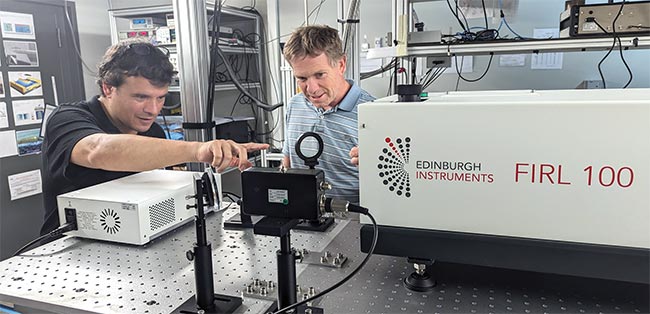
Among the notable continuous-wave (CW) terahertz sources emerging is an optically pumped Edinburgh Instruments molecular laser, used here by researchers at the Institute of Photonic Sciences in Barcelona (ICFO). It leverages a carbon dioxide infrared laser as a pump source to excite polar molecules to higher energy levels, leading to the emission of terahertz radiation. Courtesy of ICFO.
To fully unlock the potential of this spectral region, the development of reliable terahertz radiation sources is paramount. These sources can be broadly categorized into two main types: ultrashort pulse and continuous-wave (CW) sources.
The generation of pulsed terahertz radiation involves femtosecond lasers,
for example, with the laser pulse being
divided into two parts. One part is directed toward the terahertz emitter, while the other part, after interacting with a sample, goes to the detector. The ultrashort laser pulse generates a current transient in the emitter that gives rise to an electromagnetic wave packet spanning a broad spectrum within the terahertz range. In the detector, the incident terahertz pulse modifies material properties such as conductivity or birefringence, and the laser pulse probes this effect.
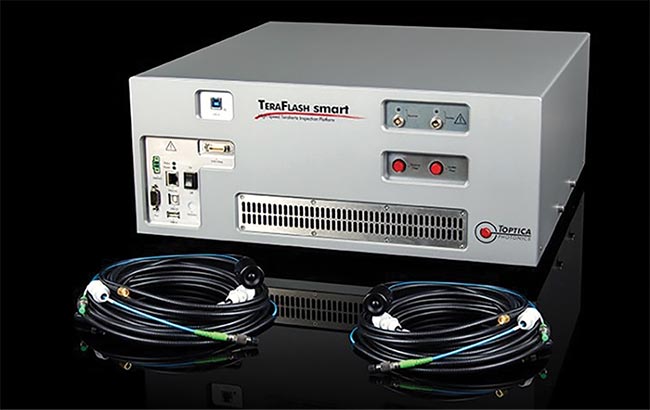
Femtosecond-pulsed lasers are also driving new sources for applications such as terahertz time-domain spectroscopy (THz-TDS). TOPTICA’s most advanced time-domain terahertz platform, for example, employs an ultrafast delay stage to acquire 1600 pulse traces per second. Courtesy of TOPTICA.
A fast Fourier transform of the terahertz amplitude trace produces the terahertz spectrum. For example, TOPTICA’s TeraFlash Pro time-domain terahertz platform employs a highly precise delay stage with a time resolution of 1.3 fs, which achieves a bandwidth of 6 THz and a peak dynamic range of >100 dB in <20 seconds1. The TeraFlash smart platform replaces the traditional mechanical delay with an ultrafast electronic one to acquire 1600 pulse traces per second.
Femtosecond-pulsed lasers are pivotal in terahertz time-domain spectroscopy (THz-TDS) where they offer broad bandwidth. These pulsed sources, however, often present limitations when it comes to frequency resolution. Applications demanding higher frequency resolution or single-frequency excitation generally favor CW terahertz sources.
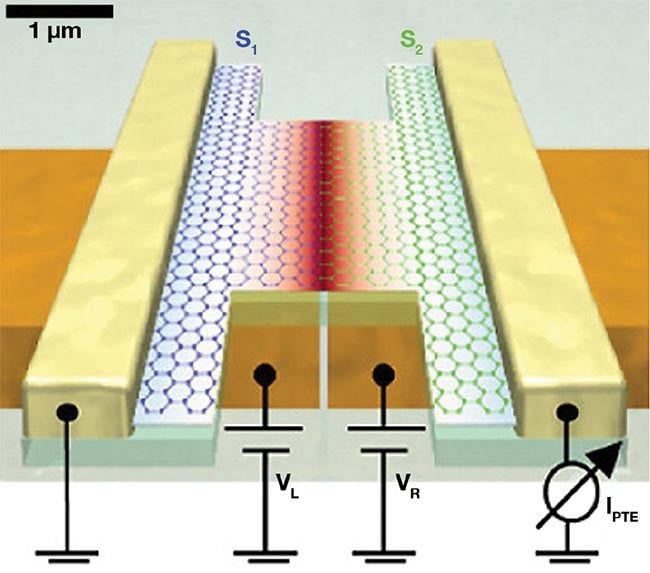
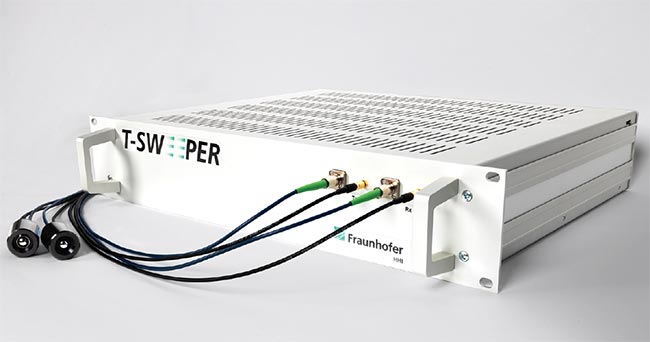
Fast-evolving terahertz detector schemes are enabling innovative new cameras and spectrometers targeting the spectrum. A schematic of the Institute of Photonic Sciences in Barcelona’s (ICFO’s) fast, sensitive experimental terahertz detection system that leverages an antenna-integrated graphene p-n junction (top). Courtesy of ICFO. The Fraunhofer Heinrich Hertz Institute’s (HHI’s) frequency-modulated continuous wave (CW) terahertz sweeper (bottom). Courtesy of ICFO and Fraunhofer Heinrich Hertz Institute.
In the realm of commercially available CW sources, an array of technologies comes into play, including difference-
frequency generation, backward wave
oscillators, microwave frequency multipliers, quantum cascade lasers, and optically pumped molecular lasers.
Notable among these options is the optically pumped terahertz molecular laser, also known as the optically pumped far-infrared (OPFIR) laser or terahertz gas laser, developed by Edinburgh Instruments. This system leverages a carbon dioxide infrared laser as a pump source to excite polar molecules to higher energy levels, leading to the emission of terahertz radiation. It offers high-power, coherent
terahertz radiation across a broad frequency range and can be configured as a stand-alone unit or integrated into existing setups, making it a valuable tool in terahertz research laboratories.
Terahertz sources
Terahertz technology holds immense promise across various applications due to its unique properties. Unlike ultrasonic nondestructive testing methods, terahertz systems do not require physical contact with the sample, which makes them ideal for inspecting lightweight, foam-like materials. Many industrially relevant materials, such as plastics, coatings, ceramics, and semiconductors, exhibit transparency and material contrast in the terahertz range, enabling high-resolution depth profiling down to 1 µm.
Present applications of terahertz technology encompass measuring coating depth, inspecting aircraft, and assessing the quality of battery anodes for electromobility. Terahertz technology has led to substantial quality improvements in all of these uses. However, one remaining challenge is to achieve 100% inspection through terahertz imaging with a full scan of the test specimen.
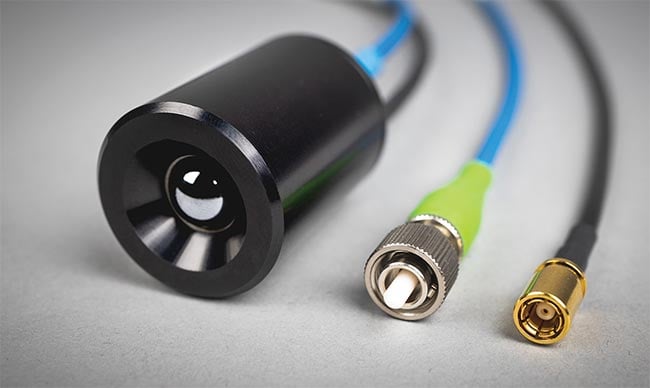
A fiber-coupled terahertz module developed by Fraunhofer Heinrich Hertz Institute (HHI). Courtesy of ICFO and Fraunhofer Heinrich Hertz Institute
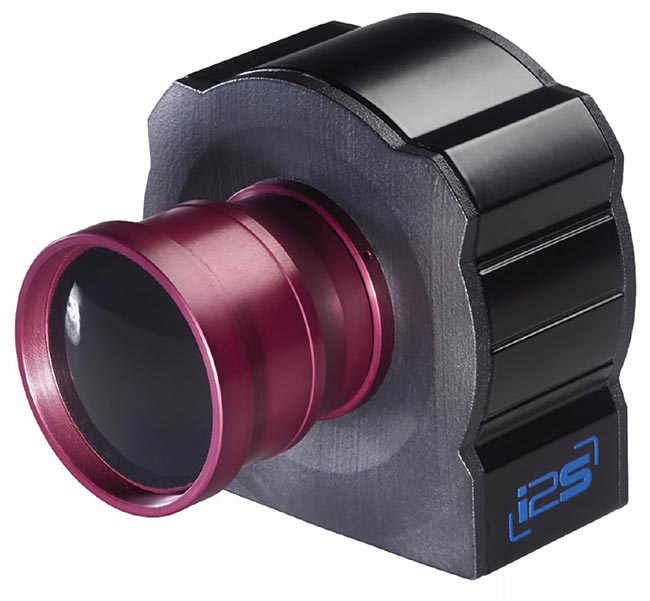
CEA-Leti developed a 320 × 240 bolometer array integrated into an uncooled terahertz camera able to capture images in that spectrum in real time. Courtesy of CEA-Leti.
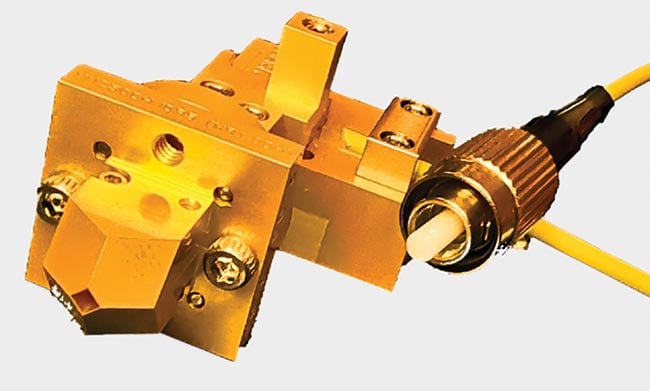
A 300-Gb terahertz transmitter developed by Microwave Photonics for high data-rate wireless applications. Courtesy of Microwave Photonics.
During the last decade, the Fraunhofer Heinrich Hertz Institute (HHI) has been at the forefront of terahertz technology.
The institute has made significant advancements in both pulsed and CW terahertz technologies. HHI’s research on pulsed terahertz technology has yielded groundbreaking results, including increased bandwidth and dynamic range. With regard to CW sources, it has developed fiber-coupled emitters and receiver modules that have expanded the possibilities for coherent terahertz spectroscopy2. In 2021, HHI successfully demonstrated
a coherent CW terahertz measurement system with a signal-to-noise ratio of 112 dB and a bandwidth of 4.5 THz. Its ongoing research focuses on photonic integration techniques to shrink the size of terahertz systems to make them more compact and affordable.
HHI is actively involved in developing photonic components for wireless communication at subterahertz frequencies, where demand for unallocated channels and high data rates in next-generation wireless communication is driving the need for photonic solutions. Unlike electronic solutions that necessitate multiple mixer stages for frequency up-conversion, photonic solutions leverage a single-step photomixing process for down-conversion from the optical domain to the terahertz domain. This approach offers wider bandwidth, low phase noise, and broader integration possibilities within optical fiber networks.
In groundbreaking experiments, HHI researchers combined photonic terahertz emitters with electronic monolithic
microwave chip-based receivers to achieve data rates up to 160 Gbit/s at
300 GHz. They have also demonstrated fully photonic links using both terahertz transmitters and receivers. These advancements have the potential to revolutionize high-speed wireless communications.
Terahertz detectors
Terahertz photodiodes are another
increasingly essential component technology supporting a wide range of high-frequency applications, encompassing radar, wireless communication, spectroscopy, imaging, and sensing. Among the various photodiode structures, uni-traveling carrier (UTC) photodiodes stand out, especially for terahertz applications. These devices employ high-mobility electrons as active carriers, reducing junction transit time and enhancing high-frequency response. Consequently, they achieve high-saturation output power and offer a wide bandwidth.
Waveguide-type terahertz photodiodes provide distinct advantages, enabling independent optimization of the absorber layer thickness and optical coupling.
This results in high responsivity and high-saturation output power. Companies such as Microwave Photonics offer
photodiode modules for terahertz applications, delivering flexibility across
operational frequencies, spanning from 220 to 325 GHz.
Researchers at the Institute of Photonic Sciences in Barcelona (ICFO) have introduced an innovative graphene-based photodetector that transcends the limitations of existing terahertz detectors3. This room-temperature-operating photodetector offers high sensitivity, rapid response, a broad dynamic range, and coverage over a wide spectrum of terahertz frequencies.
By integrating a dipole antenna into the detector to focus terahertz light, this technology concentrates incident light on the graphene channel to generate hot carriers. This design results in a highly sensitive, fast-response detector with a wide dynamic range and broad spectral coverage, and it could potentially lead to the development of low-cost, fully digital terahertz camera systems. More recently, ICFO researchers demonstrated an ultra-broadband photodetector based on twisted double bilayer graphene heterostructures spanning the spectral range of 2 to 100 μm with internal quantum efficiencies of ~40% at speeds of 100 kHz4.
Terahertz spectroscopy and imaging
Terahertz time-domain spectroscopy (THz-TDS) is a valuable tool for assessing various material properties, such as the thickness of functional coating layers in manufacturing processes. However, for industrial applications such as lithium-ion battery production, THz-TDS requires rapid in-line measurement capabilities.
ETH Zurich has developed a novel technology capable of generating two ultrafast lasers within a single optical cavity to address this challenge5. ETH Zurich’s dual-comb laser system not only lowers complexity but also supports high-speed measurements with reduced noise compared with traditional laser sources.
Building on its expertise in microbolometer imaging technology, CEA-Leti took a different approach to terahertz sensing technology. It developed a real-time terahertz imager and integrated the sensor into an uncooled camera, further expanding terahertz technology’s potential in research and industrial applications6. CEA-Leti is actively working on advancing its terahertz bolometers to
target significant improvements in sensitivity and enable real-time, high-resolution, portable imaging systems.
The Center for Physical Sciences and Technology (FTMC) in Vilnius, Lithuania, has taken another unique approach to enhancing terahertz imaging systems7. They employed laser ablation technology to fabricate high-resistivity silicon diffractive optical elements. This technological innovation reduces the size of terahertz imaging setups by eliminating the need for bulky optical parabolic mirrors and lenses. Additionally, it enables the generation of structured terahertz light using silicon diffractive optics. The
research demonstrated the potential of this approach in various applications, including the imaging of human colon tissues for cancer diagnosis.
More applications
In that vein, terahertz technology has significantly affected the field of medical science by offering a noninvasive means of medical imaging. Unlike x-rays or gamma rays, terahertz waves can penetrate biological tissues without causing harm. Terahertz holography, a technique that employs these waves to construct 3D images of biological tissues, has shown particular potential. The technology can be employed for early cancer detection,
tissue analysis, and research into biological structures. The ability to create high-resolution, noninvasive images of biological tissues also opens new avenues for diagnosing diseases and understanding the intricacies of human biology.
In the realm of security, terahertz radiation plays a pivotal role in identifying concealed objects, drugs, or explosives. Terahertz waves also possess the unique ability to peer through fabric and even some packaging materials. In scenarios such as airport security and border control, terahertz technology has proved to
be instrumental in enhancing safety
measures and preventing potential threats.
Astronomy represents another field in which terahertz photonics is making significant strides. Astronomers are using terahertz detectors and sources to study celestial objects and explore the composition and properties of cosmic dust, a
critical component in the formation of stars and planets.
The pharmaceutical industry has also harnessed the power of terahertz tools where the technology plays a vital role in the analysis of drug formulations and the detection of counterfeit medicines. By employing terahertz spectroscopy, researchers can precisely determine the composition and structure of pharmaceutical products. This not only ensures the quality and authenticity of medications but also expedites the drug development process by providing accurate information about the properties of various compounds.
Materials science, a foundational field of research with broad applications, leverages terahertz photonics for a range of purposes. Researchers can use terahertz waves, for example, to nondestructively analyze the properties and quality of materials from polymers to semiconductors. Additionally, terahertz technology offers insights into the electronic properties of materials, aiding in the development of advanced electronics and novel materials.
Fundamental physics research, particularly in the field of semiconductors, is also taking advantage of terahertz radiation to induce quantum oscillations.
These oscillations provide a deeper understanding of material behavior at the quantum level and could contribute to the development of unique electronic devices and quantum technology.
The surge of versatile new tools enabled by terahertz photonics is only beginning to gain momentum as applications grow in imaging, communication, spectroscopy, and other fields. But technological advancements are also quickly progressing in terahertz sources and detectors to offer increasing precision and control over radiation in this still under-explored spectral region.
References
1. D. Molter et al. (2022). Kilohertz pixel-rate multilayer terahertz imaging of subwavelength coatings. Appl Sci, Vol. 12, No. 10, p. 4964.
2. R.B. Kohlhaas et al. (2022). Ultrabroadband terahertz time-domain spectroscopy using
III-V photoconductive membranes
on silicon. Opt Express, Vol. 30, No. 13,
pp. 23896-23908.
3. S. Castilla et al. (2019). Fast and sensitive terahertz detection using an antenna-integrated graphene pn junction. Nano Lett,
Vol. 19, No. 5, pp. 2765-2773.
4. H. Agarwal et al. (2023). Ultra-broadband photoconductivity in twisted graphene
heterostructures with large responsivity.
Nat Photon. www.doi.org/10.1038/s41566-023-01291-0.
5. B. Willenberg et al. (2023). Gigahertz single-cavity dual-comb laser for rapid time-domain spectroscopy: from few
terahertz to optical frequencies. arXiv. www.doi.org/10.48550/arXiv.2302.10526.
6. A. Fournol et al. (2022). Cooled bolometer design for high-sensitivity THz passive imaging. Proc 47th Int Conf On Infrared, Millimeter and Terahertz Waves, pp. 1-2, Delft, Netherlands.
7. G. Valušis et al. (2021). Roadmap of
terahertz imaging 2021. Sensors (Basel), Vol. 21, No. 12, 4092.